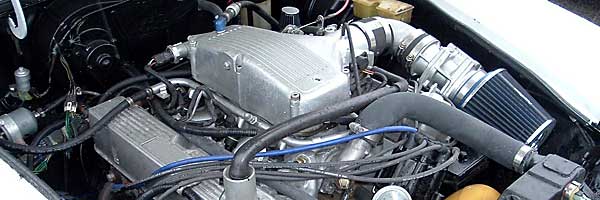
A Rover 14CUX Electronic Fuel Injection Installation (Installed by Glen Towery. Photo by Greg Myer.)
Service and Troubleshoot Rover 14CUX Electronic Fuel Injection
The British V8 Newsletter, Volume XV Issue 1by: Curtis Jacobson
INTRODUCTION
For those considering updating a carbureted Buick, Oldsmobile or Rover aluminum V8 engine to electronic fuel injection, the Rover "hot-wire" system is the most logical starting point. The hot-wire mass air flow (MAF) system automatically adapts to conditions such as temperature, humidity, and altitude. The system also automatically adapts to vehicle modifications, such as changes to the air filter or exhaust system, and to differences in fuel quality. No more carburetor jets and no more guesswork! Unlike carburetors, MAF-based electronic fuel injection is automatically self tuning.The goal of this article is to provide general background information on these systems. This article will focus specifically on the "14CUX" version of Rover electronic fuel injection because it's the newest, most developed, and most widely available of the three generations of Rover hot-wire systems that are feasible to retrofit.
A complete 14CUX system can be bought second-hand quite economically because many Range
Rovers are being retired, and because many people in our community of engine swappers
prefer the simplicity of carburetors. But what on Earth are they thinking!?! The Rover
system will typically provide a more "drivable" engine, a little more horsepower,
significantly less pollution, and certainly better fuel economy. Some carburetor designs
and installations are negatively affected by acceleraton (including cornering and braking.)
EFI installations typically have no problems with radical acceleration. Finally, EFI
provides fresh new technical challenges to keep us geeky tech types learning and growing,
and it opens up whole new performance opportunities for us to play with.
What about finding information for troubleshooting and tuning? Or the unknown cost and availability of spare Range Rover parts? Those are fair questions... so this article compiles and presents a whole lot of troubleshooting and tuning information, and even includes tips about economical spare parts and alternative sources.
Range Rovers built for other world markets (to 1990), Rover SD1 cars, and non-carbureted Triumph TR8 cars featured an entirely different and more primative sensor technology. Specifically, they used the Bosch L-Jetronic (L for "luft") "moving flap" air flow meter in which the moving current of induction air pushes past a spring-loaded vane. The Bosch L-Jetronic sensor dates back to about 1974. Some of the mechanical parts of these systems may be interesting to engine swappers, but the sensor and Lucas's analog electronic control system generally aren't.
The Lucas/Hitachi hot-wire MAF sensor was used with three different generations of Electronic Control Unit. With each generation the control system's electronic hardware and its programming improved, so the final version is preferable. The final version of Lucas electronic fuel injection was called "14CUX". 14CUX system were installed from 1990 through 1995 on engines with displacements of 3.9 and 4.2 liters.
The 14CUX's immediate predecessor was called 14CU. This system was used on US-market 1989 Range Rovers with 3.9L engines. It's largely similar to the 14CUX system, but the 14CUX provided several new features. Most notably, the 14CUX system included an auxiliary module to assist troubleshooting by displaying numeric fault codes (as shown below). Also, the 14CUX system came with a newer generation of Bosch fuel injectors which provide more power and approximately one mile per gallon better fuel economy. (The newer injectors are easy to retrofit to 13CU and 14CU systems.)
What came before the 14CU system? U.S. (and Swiss) market 1987 and 1988 Range Rovers with 3.5L engines came with a system called 13CU. The 13CU computer is easy to differentiate from later computers because the housing is quite different. Just look for pop-rivets.
One of the coolest things about the Rover 14CUX system is that it will self-adapt to many of our cars. For example, it will work fine with a wide range of compression ratios and exhaust systems. There are a couple notable exceptions. For example, the 14CUX system has a hard time adapting to a cam with a lobe separation angle under 112 degrees.
What about finding information for troubleshooting and tuning? Or the unknown cost and availability of spare Range Rover parts? Those are fair questions... so this article compiles and presents a whole lot of troubleshooting and tuning information, and even includes tips about economical spare parts and alternative sources.
BACKGROUND INFORMATION
The Lucas/Hitachi hot-wire MAF sensor was used on Range Rovers from their introduction in the US market in 1987.Range Rovers built for other world markets (to 1990), Rover SD1 cars, and non-carbureted Triumph TR8 cars featured an entirely different and more primative sensor technology. Specifically, they used the Bosch L-Jetronic (L for "luft") "moving flap" air flow meter in which the moving current of induction air pushes past a spring-loaded vane. The Bosch L-Jetronic sensor dates back to about 1974. Some of the mechanical parts of these systems may be interesting to engine swappers, but the sensor and Lucas's analog electronic control system generally aren't.
The Lucas/Hitachi hot-wire MAF sensor was used with three different generations of Electronic Control Unit. With each generation the control system's electronic hardware and its programming improved, so the final version is preferable. The final version of Lucas electronic fuel injection was called "14CUX". 14CUX system were installed from 1990 through 1995 on engines with displacements of 3.9 and 4.2 liters.
The 14CUX's immediate predecessor was called 14CU. This system was used on US-market 1989 Range Rovers with 3.9L engines. It's largely similar to the 14CUX system, but the 14CUX provided several new features. Most notably, the 14CUX system included an auxiliary module to assist troubleshooting by displaying numeric fault codes (as shown below). Also, the 14CUX system came with a newer generation of Bosch fuel injectors which provide more power and approximately one mile per gallon better fuel economy. (The newer injectors are easy to retrofit to 13CU and 14CU systems.)
What came before the 14CU system? U.S. (and Swiss) market 1987 and 1988 Range Rovers with 3.5L engines came with a system called 13CU. The 13CU computer is easy to differentiate from later computers because the housing is quite different. Just look for pop-rivets.
One of the coolest things about the Rover 14CUX system is that it will self-adapt to many of our cars. For example, it will work fine with a wide range of compression ratios and exhaust systems. There are a couple notable exceptions. For example, the 14CUX system has a hard time adapting to a cam with a lobe separation angle under 112 degrees.
For special applications like engines with aggressive cams or with displacement
enlarged to more than about 4.2L (258cid), one should strongly consider purchasing
specially programmed replacement control chips. Especially in England, there are
quite a few people hot-rodding Range Rovers and TVR sports cars for off-road
performance and competition. The expertise certainly exists to reprogram a 14CUX
ECU for good driveability to 4.6L (283cid) and even beyond, but it's not a
do-it-yourself job.
Another option for people who want electronic fuel injection on a highly modified Buick, Oldsmobile or Rover aluminum V8 is to use the basic Rover mechanical parts but select a different control system. The most obvious choice is called "MegaSquirt".
MegaSquirt doesn't require an air flow sensor because Megasquirt systems don't measure air flow. Instead, they use a Manifold Absolute Pressure (MAP) sensor, an Intake Air Temperature (IAT) sensor, and usually one or more oxygen sensors. Removing the air flow sensor has the benefit of eliminating some restriction in the induction air path, and may subsequently facilitate supercharging, turbocharging, or cowl induction.
The big downside of a MAP-based EFI system such as MegaSquirt is that it needs a complex customized "map" to relate manifold pressure to mass flow. The map can't automatically adapt to changing operating parameters. So, for example, if you change the air-filtration or exhaust system on an engine with MegaSquirt you can expect to spend some time driving around with a laptop computer to modify the fuel map based on empirical feedback from the wideband oxygen sensors. (I'm told this is a great educational exercise. It's analogous to carburetor re-jetting.)
The Rover 4.0L and 4.6L engines from 1995 to 1999 featured the next word in Rover engine management systems. Called "GEMS", these engines are easy to identify by the 4.0 or 4.6 cast into their intake plenums. The 4.0L and 4.6L control systems will be more challenging to retrofit to older engines because, for one thing, they control both fuel and ignition from one computer. Although many of the mechanical parts are similar, GEMS differs from its predecessors in that it's a sequential multi-port system: each injector is individually controlled instead of the injectors being batch-fired in banks of four. On the ignition side, GEMS is a direct ignition system utilizing four coils. (It provides spark to two cylinders at a time using the well-proven "wasted spark" principal.)
The Rover 4.0L and 4.6L engines from 1999 to 2002 featured the last word in Rover engine management systems. Called "Motronic", these engine management systems were designed and produced by Robert Bosch GmbH. The associated induction system is easy to identify, with prominant curved aluminum intake runners. (These were part of a twin-plenum design with longer runners than earlier Rover systems.) The Bosch "Motronic" EFI system had next to nothing in common with earlier Rover systems. Instead, they showed BMW's temporary influence on Range Rover design.
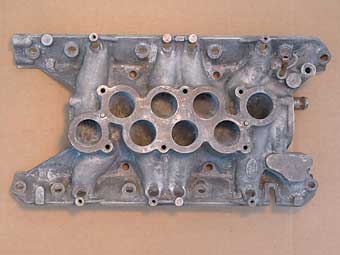
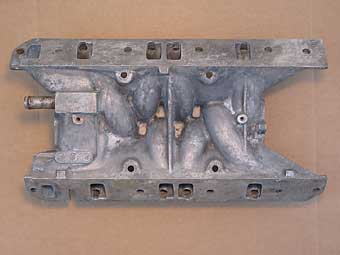
Intake Manifold
If you look closely at the Intake Manifold photographs above, you'll see that the fuel injector bosses are at the very bottom of the runners. The injectors spray right into the cylinder head intake ports.
The Rover EFI intake manifold will bolt right onto all Buick, Olds, and Rover aluminum V8 engines, but to assure that the injector spray patterns aren't obstructed it may be necessary to notch the valley pan gasket and also file small reliefs into the edges of the head ports in the immediate vicinity of the injectors. On the other hand, this may NOT be necessary. Jim Stuart reports that his 14CUX-equipped Buick 215 performed flawlessly without any head-port-to-injector clearance added. See the Fuel Injector section below for a close-up view of the manifold ports.
Next to each fuel injector boss is a short raised column. Four of these columns have been drilled and tapped for mounting the fuel rail.
The top surface of the manifold mates to the Plenum Base. It's interesting to note that the Plenum Base and the Plenum Chamber can be installed with the throttle body facing toward either the "driver's side" or the "passenger side". These three major parts are held together by six bolts, but the Plenum Base is also aligned by two steel pins pressed into the manifold.
In the left-hand photo above you can see a threaded hole where the coolant temperature sensor is installed. I've been warned that at some point Rover changed sensors from one with standard pipe threads to one with metric threads, although I've not been able to confirm this. Near the sensor hole you can see a nipple where a hose can be attached for the throttle body warmer. (See below for more info.)
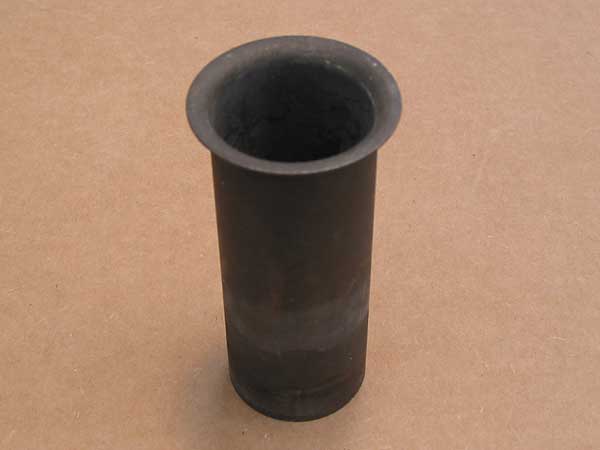
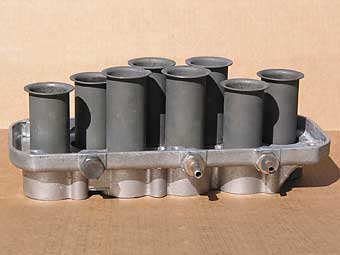
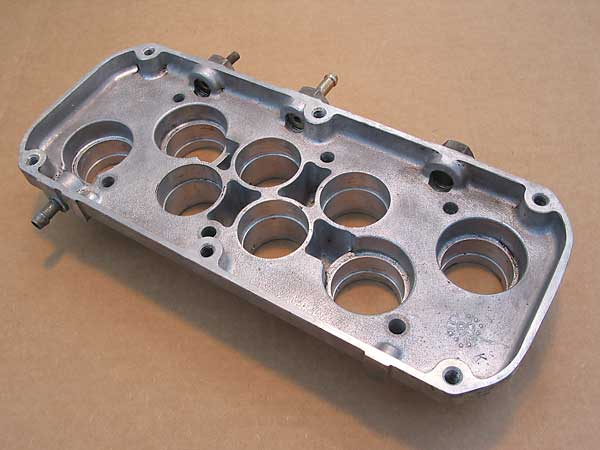
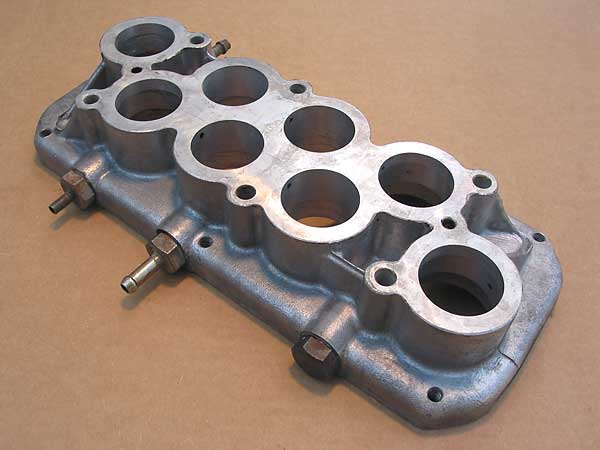
Plenum Base (with eight steel "trumpets")
The top left-hand photo in this set shows one of the steel "trumpets" that insert into the Plenum Base and extend upward into the bottom of the Plenum Chamber. The trumpets are all the same length: 100mm. When you see them installed, as in the top right-hand photo, they appear to be two different lengths, but in fact that's just because the holes they're inserted into are machined to different depths.
When you disassemble the plenum assembly you'll find the internals are coated with oil and fuel residue, partly because the crankcase ventilation system feeds into it. To drain the resulting condensation, Rover drilled holes into the Plenum Base that drain back into the intake runners below the trumpets. Those holes can be seen in the photos.
The Rover 14CUX fuel injection system is relatively "tall", so its mechanical components typically must be modified to get it under the bonnet of a sports car. The easiest and most obvious way to reduce the system's height is by milling the bottom surface of the plenum base. In many installations, that's not sufficient and additional milling is required on the top surface of the plenum base and/or the bottom surface of the plenum chamber. Some or all of the steel trumpets may require shortening to accomodate these changes.
So, the first step is to remove the trumpets from the plenum base. You may be surprised to learn they are NOT an interference fit, and in fact they would pull out easily if they were clean. When you're ready to disassemble your plenum, it's likely that most or all of them will be stuck. Getting the trumpets loose is easy if you know the trick: heat the parts in an oven! The aluminum Plenum Base will expand more than the steel trumpets, and you'll be able to simply pull the trumpets out by hand. (Perhaps the heat also loosens gasoline/oil deposits.) Obviously you should first degrease the parts so you don't stink up your kitchen. Wear hot mitts!
From personal experience I can advise that the trumpets will come out easily if the parts are hot enough, but they cool quickly! Several cycles of going in-and-out of a 400° oven will be required. If you get a particularly stubborn trumpet you can gently cool it by wetting a thin strip of cloth in water and lowering it into the tube. The cloth doesn't have to actually contact the steel trumpet to have a dramatic and rapid cooling effect. When steel cools it will contract. Be very careful though, because the steam produced could easily burn you badly. Wear your safety goggles!
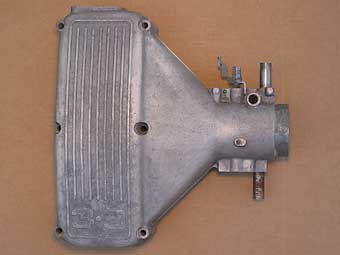
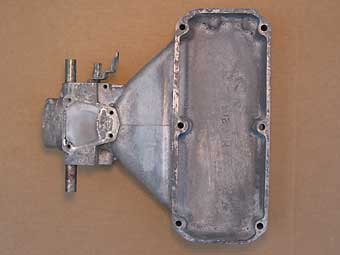
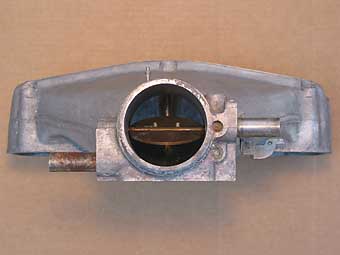
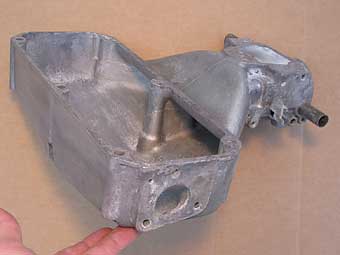
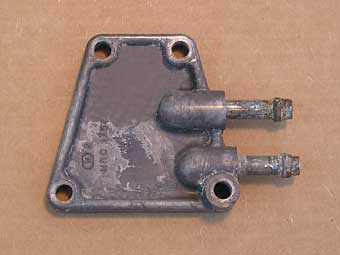
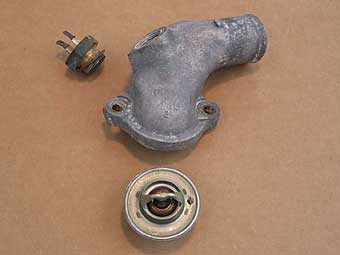
Plenum Chamber (with integral throttle body)
The lengths and diameters of runners in the intake system, and also the volume of air in the plenum from which they draw air will affect the performance characteristics of the overall system. Although we lack the resources to comprehensively and scientifically evaluate the performance effects of modifying these components, we can make a few physical measurements and see how they fit "rules of thumbs" published by others.
The inside diameter of each trumpet is 3.81cm. The cross-sections of the runners in the cylinder heads are significantly smaller, but in the intake manifold the runners quickly transition up to round cross-sections of about 3.8cm diameter each. The average total length of all eight runners measured from intake valve to open plenum is about 38.75cm. (Runners 1 and 8 are approximately 41cm long. Runners 2 and 7 are approximately 39cm long. Runners 3 thru 6 are approximately 37.5cm long.)
Based on these measurements, and on articles written by engine guru David Vizard describing the behavior of Helmholtz Resonance induction systems, we can calculate that the Rover induction tract seems to be tuned to achieve peak torque at approximately 5130rpm. Furthermore, according to David Vizard's explanation and formulas, if the runner length is shortened the induction tract's tuning will be shifted to achieve peak torque at an even higher engine speed. (If the shortened runners average 37.95cm, the system will be tuned to provide peak torque at about 5310rpm.)
A quick-and-dirty check revealed that the total air volume of the plenum (base plus chamber to the throttle plate, minus the trumpets) is in the ballpark of 3250cc.
The 14CUX system's "throttle body" is fully integrated into the plenum chamber. The throttle butterfly is 65mm in diameter.
Typically a molded rubber hose elbow is used to connect the MAF sensor to the plenum chamber. The hose flange on the plenum chamber measures 73mm diameter. (The hose flange on the MAF sensor is a little larger; it measures 80mm diameter.)
The two 5/8" O.D. steel pipe nipples are for connection to the positive crankcase ventilation valve and the idle air bypass valve respectively.
Idle speed is NOT adjusted at the throttle linkage as it would be for a carburetor. As a rule, idle speed is self-adjusted by the EFI system. For instructions on how to manually adjust idle speed, please refer to the Air Flow Sensor section below.
The photo on the bottom left shows a plate that mounts underneath the throttle and apparently is intended to warm it to prevent "icing" right at the throttle butterfly. One of the coolant hoses for this plate connects to a nipple on top of the intake manifold, near the the coolant temperature sensor. Most engine swappers discard these components and plug their holes.
The photo at right shows the thermostat housing, thermostat, and a a second coolant temperature sensor that isn't used by the fuel injection system. Incidentally, care should be taken when installing the thermostat to align the vent hole in the thermostat at "12 o'clock."
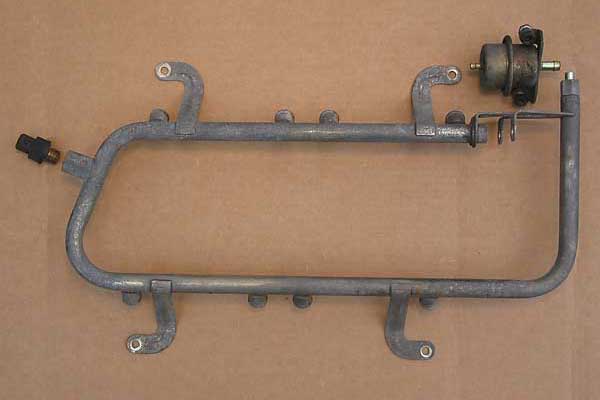
Fuel Rail and Fuel Pressure Regulator (fuel temperature sensor is also shown)
The Fuel Rail provides fuel to all eight injectors. For the fuel injectors to operate properly, a fairly constant fuel pressure is required, so a Fuel Pressure Regulator is mounted on the fuel rail at the rear of the plenum chamber. The regulator is a mechanical device controlled by plenum chamber vacuum; it ensures that fuel rail pressure is maintained at a constant pressure difference of 2.5 bar above that of the manifold. When pressure exceeds the regulator setting excess fuel is returned to the fuel tank.
To check the fuel pressure, a gauge is fitted to the supply line immediately after the fuel filter. The ignition is powered up, and the gauge is read. The pressure reading should be between 34.0-38.0psi (2.390-2.672 kgf/cm2). Next, turn the ignition switch off and observe the pressure drop in the system. After one minute, pressure should drop no more than 10psi (0.7 kgf/cm2). To check for a leaking injector, first check the spark plugs! (A leaking injector will typically result in a sooted-up spark plug.) Range Rover advises that all eight injectors can be removed from the manifold without being disconnected from the fuel rail (which is presumably still full of fuel.) If you can manage to get them out and inspect them for leakage, you should observe no more than two drops of fuel per minute from any injector.
The Fuel Pressure Regulator on our example system is marked "W. Germany", "Lucas", "2.5", "8RV", "84924A", and "7.21311.02".
Warning: performance tuners familiar with older fuel injection systems may be tempted to modify or replace the fuel pressure regulator to achieve fuel pressure increases at the injectors immediately upon increases in throttle opening (triggered via vacuum.) This tuning technique is not appropriate for newer electronic fuel injection systems such as the 14CUX. It's really better to avoid confusing the ECU!
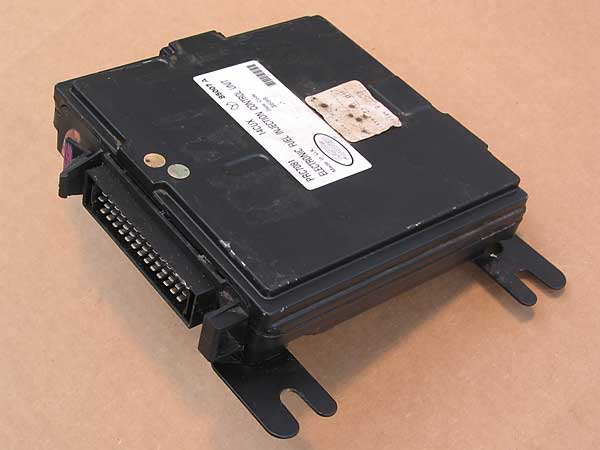
Electronic Control Unit - ECU
The Electronic Control Unit is the "brains" of the fuel injection system. On a Range Rover, the ECU is located under the front right hand seat. Various sensors are fitted to the engine to measure and to communicate operating parameters to the ECU. The ECU uses this data to quickly and constantly adjust the amount of fuel delivered. The ECU does this by modulating pulses of the electrical current that opens the fuel injectors. The fuel injectors are divided into two banks of four, and the ECU only has two "outputs" (i.e. one for each bank of injectors.) Inside the ECU, a microprocessor and other components are mounted on printed circuit boards. The ECU is connected to the main harness by a 40 pin connector. The connector terminal/cavities on the ECU housing are not labeled.
The ECU on our example system has a sticker with the following markings: "PRC7081", "14CUX", "85007A", "Electronic Fuel Injection Control Unit", "Made in U.K.", "Date Code 3689", "Land Rover" (plus a bar-code).
A second, smaller sticker on the front of our ECU is impossible to read. It's mildewed and the print is faded. Apparently there were some hand-written marks, but they're unreadable too... All the more reason for us to have a peak inside!
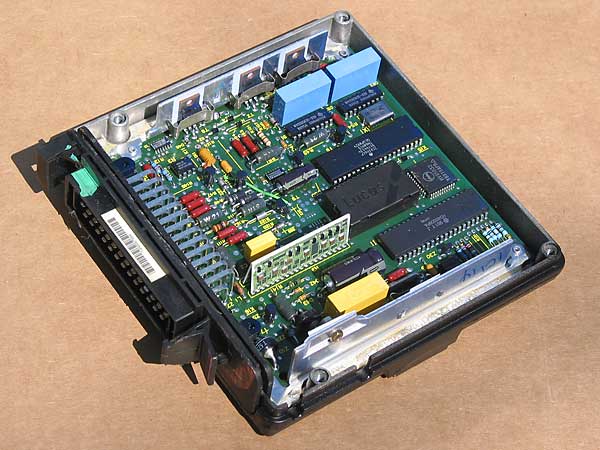
First impressions? Well, it's colorful, isn't it? From my perspective though, the
first thing to note about our 14CUX ECU is that it represents several generations
of electronics technology. Some of the big, fat resistors, capacitors and diodes
on the circuit board would be right at home in a 1960's TV set. The leads on these
"discrete components" poke through holes in the board and are soldered to traces
on the back-side. Interestingly, in between these large components you'll notice
more modern, much more highly-miniaturized surface-mounted devices (SMD). These are
mostly still individual resistors, capacitors and diodes, but they don't require
through-holes so they're more economical to install, they support greater
miniaturization overall, and additionally they're more resistant to vibration and
mechanical fatigue. SMDs were just coming into widespread automotive use in the late
1980's. There are SMDs on both sides of the main board. Their presence means two
fundamentally different types of assembly and soldering equipment were needed to
build the main circuit board.
See the bright green jumper wire? It represents some designer's embarrassing mistake, or at least a last minute design change. I bet that was one expensive piece of wire!
Another option for people who want electronic fuel injection on a highly modified Buick, Oldsmobile or Rover aluminum V8 is to use the basic Rover mechanical parts but select a different control system. The most obvious choice is called "MegaSquirt".
MegaSquirt doesn't require an air flow sensor because Megasquirt systems don't measure air flow. Instead, they use a Manifold Absolute Pressure (MAP) sensor, an Intake Air Temperature (IAT) sensor, and usually one or more oxygen sensors. Removing the air flow sensor has the benefit of eliminating some restriction in the induction air path, and may subsequently facilitate supercharging, turbocharging, or cowl induction.
The big downside of a MAP-based EFI system such as MegaSquirt is that it needs a complex customized "map" to relate manifold pressure to mass flow. The map can't automatically adapt to changing operating parameters. So, for example, if you change the air-filtration or exhaust system on an engine with MegaSquirt you can expect to spend some time driving around with a laptop computer to modify the fuel map based on empirical feedback from the wideband oxygen sensors. (I'm told this is a great educational exercise. It's analogous to carburetor re-jetting.)
The Rover 4.0L and 4.6L engines from 1995 to 1999 featured the next word in Rover engine management systems. Called "GEMS", these engines are easy to identify by the 4.0 or 4.6 cast into their intake plenums. The 4.0L and 4.6L control systems will be more challenging to retrofit to older engines because, for one thing, they control both fuel and ignition from one computer. Although many of the mechanical parts are similar, GEMS differs from its predecessors in that it's a sequential multi-port system: each injector is individually controlled instead of the injectors being batch-fired in banks of four. On the ignition side, GEMS is a direct ignition system utilizing four coils. (It provides spark to two cylinders at a time using the well-proven "wasted spark" principal.)
The Rover 4.0L and 4.6L engines from 1999 to 2002 featured the last word in Rover engine management systems. Called "Motronic", these engine management systems were designed and produced by Robert Bosch GmbH. The associated induction system is easy to identify, with prominant curved aluminum intake runners. (These were part of a twin-plenum design with longer runners than earlier Rover systems.) The Bosch "Motronic" EFI system had next to nothing in common with earlier Rover systems. Instead, they showed BMW's temporary influence on Range Rover design.
BASIC MECHANICAL PARTS


If you look closely at the Intake Manifold photographs above, you'll see that the fuel injector bosses are at the very bottom of the runners. The injectors spray right into the cylinder head intake ports.
The Rover EFI intake manifold will bolt right onto all Buick, Olds, and Rover aluminum V8 engines, but to assure that the injector spray patterns aren't obstructed it may be necessary to notch the valley pan gasket and also file small reliefs into the edges of the head ports in the immediate vicinity of the injectors. On the other hand, this may NOT be necessary. Jim Stuart reports that his 14CUX-equipped Buick 215 performed flawlessly without any head-port-to-injector clearance added. See the Fuel Injector section below for a close-up view of the manifold ports.
Next to each fuel injector boss is a short raised column. Four of these columns have been drilled and tapped for mounting the fuel rail.
The top surface of the manifold mates to the Plenum Base. It's interesting to note that the Plenum Base and the Plenum Chamber can be installed with the throttle body facing toward either the "driver's side" or the "passenger side". These three major parts are held together by six bolts, but the Plenum Base is also aligned by two steel pins pressed into the manifold.
In the left-hand photo above you can see a threaded hole where the coolant temperature sensor is installed. I've been warned that at some point Rover changed sensors from one with standard pipe threads to one with metric threads, although I've not been able to confirm this. Near the sensor hole you can see a nipple where a hose can be attached for the throttle body warmer. (See below for more info.)




The top left-hand photo in this set shows one of the steel "trumpets" that insert into the Plenum Base and extend upward into the bottom of the Plenum Chamber. The trumpets are all the same length: 100mm. When you see them installed, as in the top right-hand photo, they appear to be two different lengths, but in fact that's just because the holes they're inserted into are machined to different depths.
When you disassemble the plenum assembly you'll find the internals are coated with oil and fuel residue, partly because the crankcase ventilation system feeds into it. To drain the resulting condensation, Rover drilled holes into the Plenum Base that drain back into the intake runners below the trumpets. Those holes can be seen in the photos.
The Rover 14CUX fuel injection system is relatively "tall", so its mechanical components typically must be modified to get it under the bonnet of a sports car. The easiest and most obvious way to reduce the system's height is by milling the bottom surface of the plenum base. In many installations, that's not sufficient and additional milling is required on the top surface of the plenum base and/or the bottom surface of the plenum chamber. Some or all of the steel trumpets may require shortening to accomodate these changes.
|
Enjoying this article? Our magazine is funded through the generous support of readers like you! To contribute to our operating budget, please click here and follow the instructions. (Suggested contribution is twenty bucks per year. Feel free to give more!) |
So, the first step is to remove the trumpets from the plenum base. You may be surprised to learn they are NOT an interference fit, and in fact they would pull out easily if they were clean. When you're ready to disassemble your plenum, it's likely that most or all of them will be stuck. Getting the trumpets loose is easy if you know the trick: heat the parts in an oven! The aluminum Plenum Base will expand more than the steel trumpets, and you'll be able to simply pull the trumpets out by hand. (Perhaps the heat also loosens gasoline/oil deposits.) Obviously you should first degrease the parts so you don't stink up your kitchen. Wear hot mitts!
From personal experience I can advise that the trumpets will come out easily if the parts are hot enough, but they cool quickly! Several cycles of going in-and-out of a 400° oven will be required. If you get a particularly stubborn trumpet you can gently cool it by wetting a thin strip of cloth in water and lowering it into the tube. The cloth doesn't have to actually contact the steel trumpet to have a dramatic and rapid cooling effect. When steel cools it will contract. Be very careful though, because the steam produced could easily burn you badly. Wear your safety goggles!






The lengths and diameters of runners in the intake system, and also the volume of air in the plenum from which they draw air will affect the performance characteristics of the overall system. Although we lack the resources to comprehensively and scientifically evaluate the performance effects of modifying these components, we can make a few physical measurements and see how they fit "rules of thumbs" published by others.
The inside diameter of each trumpet is 3.81cm. The cross-sections of the runners in the cylinder heads are significantly smaller, but in the intake manifold the runners quickly transition up to round cross-sections of about 3.8cm diameter each. The average total length of all eight runners measured from intake valve to open plenum is about 38.75cm. (Runners 1 and 8 are approximately 41cm long. Runners 2 and 7 are approximately 39cm long. Runners 3 thru 6 are approximately 37.5cm long.)
Based on these measurements, and on articles written by engine guru David Vizard describing the behavior of Helmholtz Resonance induction systems, we can calculate that the Rover induction tract seems to be tuned to achieve peak torque at approximately 5130rpm. Furthermore, according to David Vizard's explanation and formulas, if the runner length is shortened the induction tract's tuning will be shifted to achieve peak torque at an even higher engine speed. (If the shortened runners average 37.95cm, the system will be tuned to provide peak torque at about 5310rpm.)
A quick-and-dirty check revealed that the total air volume of the plenum (base plus chamber to the throttle plate, minus the trumpets) is in the ballpark of 3250cc.
The 14CUX system's "throttle body" is fully integrated into the plenum chamber. The throttle butterfly is 65mm in diameter.
Typically a molded rubber hose elbow is used to connect the MAF sensor to the plenum chamber. The hose flange on the plenum chamber measures 73mm diameter. (The hose flange on the MAF sensor is a little larger; it measures 80mm diameter.)
The two 5/8" O.D. steel pipe nipples are for connection to the positive crankcase ventilation valve and the idle air bypass valve respectively.
Idle speed is NOT adjusted at the throttle linkage as it would be for a carburetor. As a rule, idle speed is self-adjusted by the EFI system. For instructions on how to manually adjust idle speed, please refer to the Air Flow Sensor section below.
The photo on the bottom left shows a plate that mounts underneath the throttle and apparently is intended to warm it to prevent "icing" right at the throttle butterfly. One of the coolant hoses for this plate connects to a nipple on top of the intake manifold, near the the coolant temperature sensor. Most engine swappers discard these components and plug their holes.
The photo at right shows the thermostat housing, thermostat, and a a second coolant temperature sensor that isn't used by the fuel injection system. Incidentally, care should be taken when installing the thermostat to align the vent hole in the thermostat at "12 o'clock."

The Fuel Rail provides fuel to all eight injectors. For the fuel injectors to operate properly, a fairly constant fuel pressure is required, so a Fuel Pressure Regulator is mounted on the fuel rail at the rear of the plenum chamber. The regulator is a mechanical device controlled by plenum chamber vacuum; it ensures that fuel rail pressure is maintained at a constant pressure difference of 2.5 bar above that of the manifold. When pressure exceeds the regulator setting excess fuel is returned to the fuel tank.
To check the fuel pressure, a gauge is fitted to the supply line immediately after the fuel filter. The ignition is powered up, and the gauge is read. The pressure reading should be between 34.0-38.0psi (2.390-2.672 kgf/cm2). Next, turn the ignition switch off and observe the pressure drop in the system. After one minute, pressure should drop no more than 10psi (0.7 kgf/cm2). To check for a leaking injector, first check the spark plugs! (A leaking injector will typically result in a sooted-up spark plug.) Range Rover advises that all eight injectors can be removed from the manifold without being disconnected from the fuel rail (which is presumably still full of fuel.) If you can manage to get them out and inspect them for leakage, you should observe no more than two drops of fuel per minute from any injector.
The Fuel Pressure Regulator on our example system is marked "W. Germany", "Lucas", "2.5", "8RV", "84924A", and "7.21311.02".
Warning: performance tuners familiar with older fuel injection systems may be tempted to modify or replace the fuel pressure regulator to achieve fuel pressure increases at the injectors immediately upon increases in throttle opening (triggered via vacuum.) This tuning technique is not appropriate for newer electronic fuel injection systems such as the 14CUX. It's really better to avoid confusing the ECU!
THE CONTROL SYSTEM

The Electronic Control Unit is the "brains" of the fuel injection system. On a Range Rover, the ECU is located under the front right hand seat. Various sensors are fitted to the engine to measure and to communicate operating parameters to the ECU. The ECU uses this data to quickly and constantly adjust the amount of fuel delivered. The ECU does this by modulating pulses of the electrical current that opens the fuel injectors. The fuel injectors are divided into two banks of four, and the ECU only has two "outputs" (i.e. one for each bank of injectors.) Inside the ECU, a microprocessor and other components are mounted on printed circuit boards. The ECU is connected to the main harness by a 40 pin connector. The connector terminal/cavities on the ECU housing are not labeled.
The ECU on our example system has a sticker with the following markings: "PRC7081", "14CUX", "85007A", "Electronic Fuel Injection Control Unit", "Made in U.K.", "Date Code 3689", "Land Rover" (plus a bar-code).
A second, smaller sticker on the front of our ECU is impossible to read. It's mildewed and the print is faded. Apparently there were some hand-written marks, but they're unreadable too... All the more reason for us to have a peak inside!

See the bright green jumper wire? It represents some designer's embarrassing mistake, or at least a last minute design change. I bet that was one expensive piece of wire!
Finally, note how everything (including the wire) has a glossy protective coating
of varnish over it? That's called "conformal coating", and from my experience it's
not very common on automotive electronic components anymore, except on commercial
trucks. Good for Rover!
Look a little closer, and find the mysterious black component on the board that's labeled "Lucas". Okay, it's not THAT mysterious: it's a cover over top of the chip that holds the fuel map programming for the ECU. Before removing the cover, I noticed that the conformal coating on the square chip to its right is scuffed up... someone has been here before me! (And they were prying against delicate electronic parts with a screwdriver.)
The "Lucas" cover can be pulled off with your finger tips (or with pliers). Take your time... a gentle rocking motion is called for.
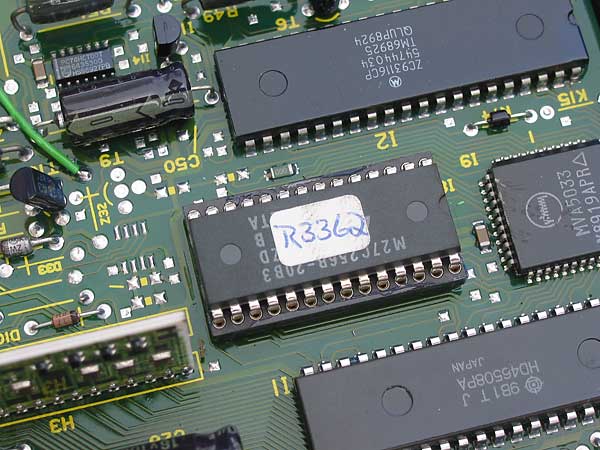
Look what I found under the cover! I bet this ECU didn't leave the Rover factory
with a hand-written label ("R3362") on its fuel-map chip. Someone has already
"re-chipped" this particular ECU!
Many people have reported that the chip isn't socket-mounted on early 14CUX ECUs, but our example ECU seems to argue otherwise.The quality of soldering on the IC chip socket, and the fact that the conformal coating covers both socket and soldering, indicate that the socket was NOT added after board assembly.
Gently peeling back the hand-written label reveals the date code "9348" and the chip part number "M27C256B-20B3". The date code indicates that this chip is about four years newer than all the other dated components in the ECU (and of course newer than the Range Rover the ECU came out of.) The part number identifies the chip as a 256 Kbit (32Kb x 8) EPROM. What's an EPROM? The acronym stands for "erasable programmable read-only memory".
The next questions are: (1) who programmed this chip and (2) what were the characteristics of the program they selected?
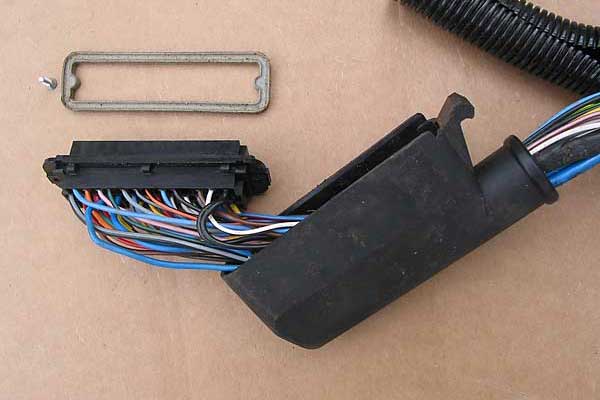
EFI Cable Harness Assembly
The EFI Cable Harness Assembly is connected to the ECU by one 40-pin Amphenol connector (part number 143-70011). The connector is sealed, but can be disassembled by removing two hidden screws from the ECU-side (they're hidden under a rubber seal.) Cable pin positions are labeled on the side of the connector that is hidden by the plastic cover. Pin positions correlate to cable insulation color codes as follows:
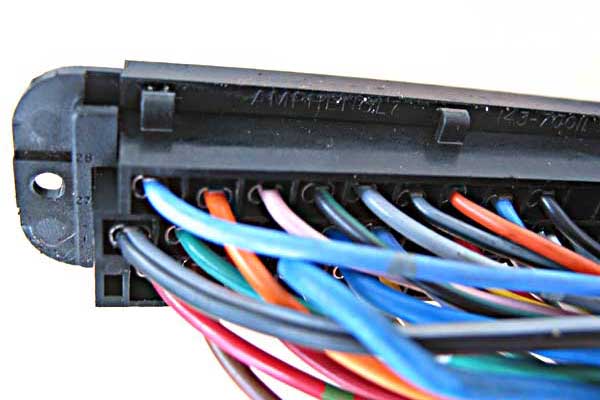
Note:
1. Where two colors are given, the first is the basic color and the second is a "stripe" or "tracer" color.
2. Pins 4, 23, 24, 30, and 31 were NOT USED on vehicles that weren't equipped with catalytic converters.
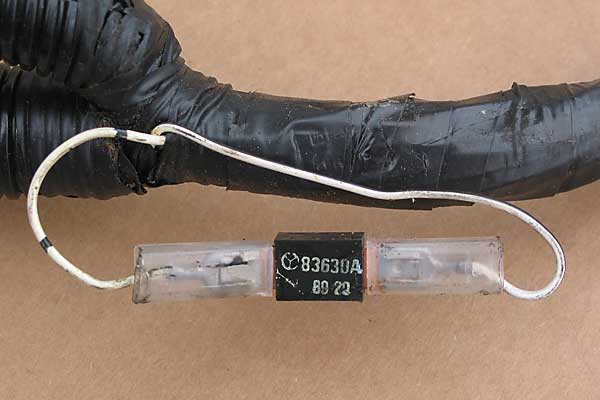
(This is NOT a "Tune Resistor".)
When visually inspecting the EFI Cable Harness Assembly, one unusual component that's
particularly conspicuous is the resistor that Rover included on the Engine Speed sense
circuit. This resistor should NOT be confused with the Tune Resistor. This circuit is the
only connection between the ignition system and the fuel injection system. A damaged or
loosely connected resistor would likely result in an open circuit, leaving the ECU
wondering about engine speed.
In our example system this resistor is marked "Lucas", "RD953066", "83630A", and "892Q". The resistor should provide about 6.8k Ohm resistance.
Look a little closer, and find the mysterious black component on the board that's labeled "Lucas". Okay, it's not THAT mysterious: it's a cover over top of the chip that holds the fuel map programming for the ECU. Before removing the cover, I noticed that the conformal coating on the square chip to its right is scuffed up... someone has been here before me! (And they were prying against delicate electronic parts with a screwdriver.)
The "Lucas" cover can be pulled off with your finger tips (or with pliers). Take your time... a gentle rocking motion is called for.

Many people have reported that the chip isn't socket-mounted on early 14CUX ECUs, but our example ECU seems to argue otherwise.The quality of soldering on the IC chip socket, and the fact that the conformal coating covers both socket and soldering, indicate that the socket was NOT added after board assembly.
Gently peeling back the hand-written label reveals the date code "9348" and the chip part number "M27C256B-20B3". The date code indicates that this chip is about four years newer than all the other dated components in the ECU (and of course newer than the Range Rover the ECU came out of.) The part number identifies the chip as a 256 Kbit (32Kb x 8) EPROM. What's an EPROM? The acronym stands for "erasable programmable read-only memory".
The next questions are: (1) who programmed this chip and (2) what were the characteristics of the program they selected?

The EFI Cable Harness Assembly is connected to the ECU by one 40-pin Amphenol connector (part number 143-70011). The connector is sealed, but can be disassembled by removing two hidden screws from the ECU-side (they're hidden under a rubber seal.) Cable pin positions are labeled on the side of the connector that is hidden by the plastic cover. Pin positions correlate to cable insulation color codes as follows:

| "Bottom Row" - pins 1 to 13 (they're numbered from left to right as shown in the photo) | ||
| 1 | Red/Green | Idle bypass valve - circuit 1 |
| 2 | Brown/Orange | Power feed to the fuel injection main relay |
| 3 | Yellow | Throttle position sensor output/reference - see also 20 and 25 |
| 4 | Black | Oxygen sensors (ground) and to the relay that powers their heater coils |
| 5 | Grey/Black | Tune resistor (through VIN LA451517 only) |
| 6 | Yellow | Road speed input |
| 7 | Green/Blue | Coolant temperature sensor (input) - see also 25 |
| 8 | Purple/Yellow | Windshield defroster input, if fitted |
| 9 | White/Light Green | Diagnostic connector output |
| 10 | Black/Yellow | "Check Engine" lamp |
| 11 | Yellow/White | Right bank of injectors - cylinders 2, 4, 6 and 8 |
| 12 | Blue/Red | Main relay "request" |
| 13 | Yellow/Blue | Left bank of injectors - cylinders 1, 3, 5 and 7 |
| "Middle Row" - pins 14 to 27 (they're numbered from right to left as shown in the photo) | ||
| 14 | Black | Ground |
| 15 | Brown | "Battery" supply |
| 16 | Blue/Purple | Fuel pump relay "request" |
| 17 | Grey/Yellow | Purge control valve output |
| 18 | White/Pink | Diagnostic connector output |
| 19 | White/Grey | "Ignition" supply |
| 20 | Red | Throttle position sensor (input) - see also 3 and 25 |
| 21 | Yellow/Black | Air conditioning thermostat input, if fitted |
| 22 | Blue/Red | Air flow sensor (input) - see also 25 |
| 23 | Blue | Signal from the LH oxygen sensor |
| 24 | Blue | Signal from the RH oxygen sensor |
| 25 | Red/Black | Ground side of coolant, fuel, airflow & throttle-position sensors |
| 26 | Green/White | Idle bypass valve - circuit 1 |
| 27 | Black/Grey | Ground |
| "Top Row" - pins 28 to 40 (they're numbered from left to right as shown in the photo) | ||
| 28 | Blue/Grey | Idle bypass valve - circuit 2 |
| 29 | Orange | Idle bypass valve - circuit 2 |
| 30 | Black | Fault display data |
| 31 | Black/Green | Diagnostic connector "request" input |
| 32 | Grey/White | Fuel temperature sensor (input) - see also 25 |
| 33 | Black/Grey | Air conditioning compressor clutch relay, if fitted |
| 34 | Orange/Black | Transmission gear switch signal |
| 35 | Blue/Green | Air flow sensor (input) - see also 25 |
| 36 | Black/Green | Air conditioning condenser fan output, if fitted |
| 37 | (Not Used) | |
| 38 | Brown/Black | Fault display data |
| 39 | White/Black | Engine speed signal cable (harness includes 6.8k ohm resistor) |
| 40 | Black | Ground |
1. Where two colors are given, the first is the basic color and the second is a "stripe" or "tracer" color.
2. Pins 4, 23, 24, 30, and 31 were NOT USED on vehicles that weren't equipped with catalytic converters.

(This is NOT a "Tune Resistor".)
In our example system this resistor is marked "Lucas", "RD953066", "83630A", and "892Q". The resistor should provide about 6.8k Ohm resistance.
Tune Resistor
A Tune Resistor was originally specified in the wire harness so that one ECU part number could serve multiple vehicle markets. (Multiple computer programs could be stored within the ECU, and the ECU could "decide" which one to use based on what resistance it sensed.) One leg of the Tune Resister was wired to terminal 5 of the ECU, and the other leg was spliced to ground.
At some point during 14CUX production, Rover apparently decided to eliminate the Tune Resistor. (According to Rover service literature, this started with VIN number LA451517.) It isn't clear from the literature whether any US-market 14CUX systems would be effected by having an incorrect or damaged tune resister. The example system we photographed and described for this article NEVER HAD A TUNE RESISTOR!
The following information on Tune Resistors is based on Rover service literature.
Note: all four types of Rover Tune Resistors were rated for 0.5 Watts.
When fitted, the Tune Resistor was connected to the ECU through terminal position 5, and it was also connected to terminal position 27 through a splice. If you wish to check the resistor, first disconnect power to the system, second disconnect the EFI Cable Harness Assembly from the ECU, and finally simply measure resistance (using an Ohmmeter) from pin 5 to pin 27 on the main ECU connector. (Resistance isn't polarity dependent.)
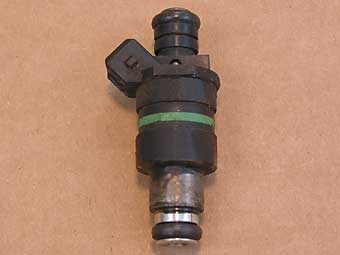
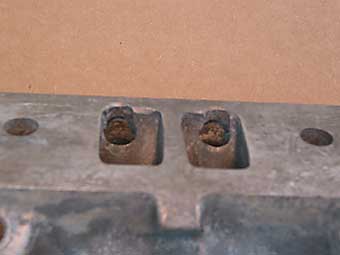
Injectors
Fuel injectors are the precision valves that meter fuel delivery. The eight fuel injectors are fitted between the pressurized fuel rail and the inlet manifold. Each injector comprises a solenoid operated needle valve with a movable plunger rigidly attached to the nozzle valve. When the solenoid is energized the plunger is attracted off its seat and allows pressurized fuel into the intake manifold.
Minimum fuel flow per injector is 160-175cc per minute using alcohol (for testing), or 180-195cc per minute using gasoline, when tested at 36.25psi (2.54kgf/cm2) at 20C +/- 2C.
Wiring faults on the injector circuits (and within the injectors) can be tested for at the ECU connector. Turn the ignition off and disconnect the ECU connector. Check the right bank of injectors by measuring resistance between terminals 2 and 11. Check the left bank of injectors by measuring resistance between terminals 2 and 13. In both cases, an Ohmmeter reading of 4-4.5 Ohms is expected. If the reading is 5-6 Ohms, suspect one bad fuel injector. A reading of 8-9 Ohms could indicate two bad injectors, and a reading of 16-17 Ohms could indicate three bad injectors. In any case, if the overall circuit resistance isn't 4-4.5 Ohms, proceed to checking for wiring faults or for open-circuit injectors.
The Injectors in our example system are marked with a green stripe painted around their circumference.
Purchasing original Bosch fuel injectors (part number ERR722, rated 23.67 lbs/hr) from the Rover dealer isn't inexpensive. In fact, even at your local discount auto parts store you can expect to pay almost $100 per injector. (Auto Zone lists GP-Sorenson part number 800-1151N at $96.99/ea. They come with a one year warranty.) Mainly for this reason, Range Rover owners have been seeking cross-references to other usable injectors for years. The internet message boards contain several (typically dramatically less expensive) cross-references (e.g. Bosch/Ford 0280150561, Accel 158021, etc.)
Since injector failure is far more likely to be from obstruction than from electrical problems, you may want to consider having your injectors professionally cleaned. One of our readers, Tony Bates, advises that this can be done for as little as $90/set. (He recommends "Affordable Fuel Injection" in Elsie Michigan.) Fuel injector service should include thorough electrical testing, ultrasonic cleaning, installation of new filter baskets and pintle caps, new o-rings, leak-down testing, spray pattern analysis, and flow testing. (Ask for the test results and make sure all the injectors are performing similarly.)
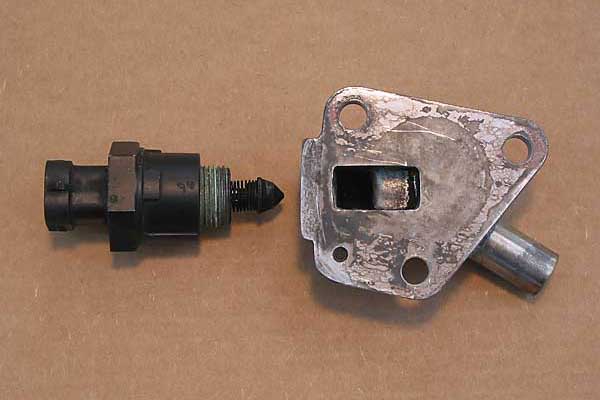
Bypass Air Valve
The purpose of the Bypass Air Valve is to provide a mechanism by which the fuel injection system can alter the amount of air delivered to the engine, especially when the engine is at idle. The "Bypass Air Valve" is actually a solenoid motor with a plunger that acts as a valve in conjunction with an aluminum casting that it mounts into. The valve-body casting is mounted on the rear surface of the plenum chamber by three bolts. The valve is connected by a rubber hose to the intake tract ahead of the throttle butterfly. The valve includes an integral stepper motor, featuring two windings that are controlled by the ECU, so the ECU can control the valve aperture. For example, the valve provides extra air to maintain idle speed when the engine is under increased mechanical load such as when the air conditioning compressor is engaged.
The Bypass Air Valve has four terminals, but on our example valve they aren't marked on the valve housing. To identify them, refer to the mating connector. You may verify continuity in the windings by measuring across terminal pair cavity-A (orange wire) and cavity-B (blue/grey wire), and then by measuring across terminal pair cavity-C (green/white wire) and cavity-D (red/green wire); in both tests Ohmmeter readings should show 40 to 60 Ohms resistance. If you prefer, you may take these measurements from the ECU connector by measuring at terminal pair 1 and 26 or terminal pair 28 and 29.
Reportedly, the Bypass Air Valve is one of the weakest links of the Rover 14CUX system. It can stick, and we're told that the most typical symptom of this is a fast idle of about 1,500rpm, and also "searching" idle speed when descending hills. WD40 can sometimes un-stick the valve temporarily. The Bypass Air Valve on our example system is marked "73312A" and "82494". The first marking is certainly a part number, and I suspect that the second marking is a date code that indicates the valve has been replaced at some point. If you're familiar with automotive wiring, you'll probably recognize that the connector and terminals for this valve are Packard Weather-Pack components. ("Packard Electrical Division" was part of General Motors, and was spun off to become part of "Delphi Automotive Systems".) The valve itself bears a striking resemblance to AC Delco part number 25527077, which was used on all 4.3L GM V6 engines and most 5.7L GM V8 engines. If you need one of these valves, purchasing the General Motors spec part from your local parts counter will be considerably more economical than dealing with Range Rover.
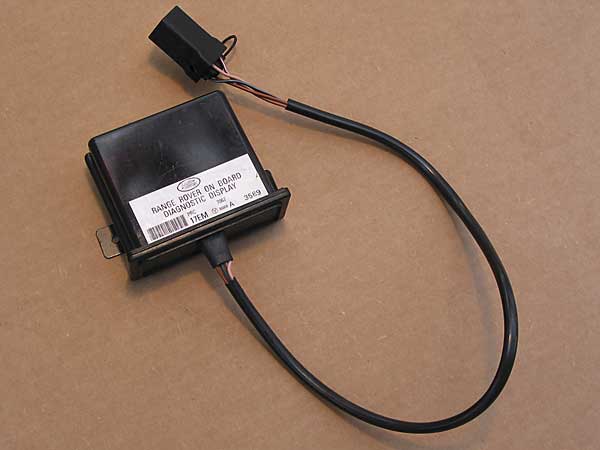
Fuel Injection Fault Display
The fuel injection fault display provides two-digit diagnostic codes in a way that's very easy to read: the display has a dark red, transparent, molded plastic case. Light emitting diodes can be seen through the side of the case when a fault code is displayed. Nifty!
If multiple faults exist, the display shows the one that the ECU thinks is highest priority. Higher priority faults need to be "cleared" before lower priority faults will be displayed. A "blank" (dark) display usually indicates there are no faults.
Use this procedure to clear faults:
1. Switch "on" the ignition.
2. Disconnect the serial link mating plug, wait five seconds, and reconnect.
3. Switch "off" the ignition, and wait several seconds.
4. Switch "on" the ignition. The display should now reset.
Note: It should either show a lower priority fault code or appear dark.
Note: Fault code "02" will appear after a disconnected ECU is reconnected. Simply switch on the ignition to clear the display.
The Fuel Injection Fault Display on our example system is marked "Land Rover", "Range Rover On Board Diagnostic Display", "PRC", "7067", "17EM", "85008A", and "3589". It has a 4-lead pigtail on it that's about 18" long, and the 5-pin connector on the end of the pigtail is unmarked except for terminal cavity numbers.
The wires are connected as follows: 1 - Brown/Orange, 2 - Black/Grey, 3 - Pink, 4 - Not Used, and 5 - Brown/White.
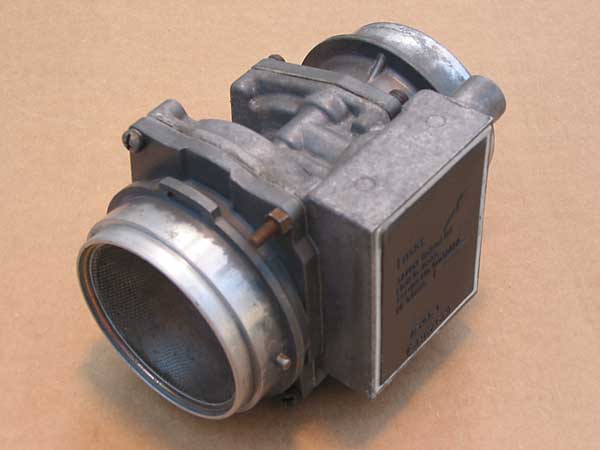
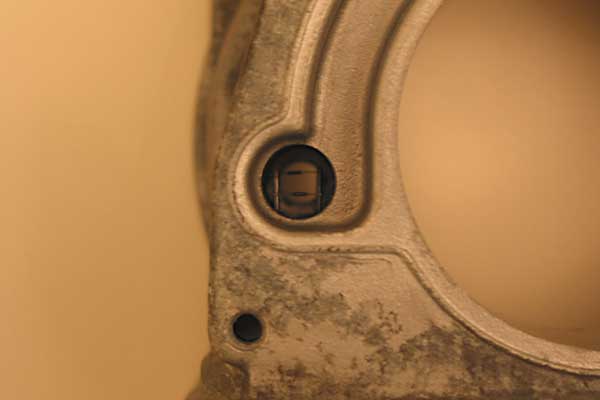
Mass Air Flow Sensor
The Mass Air Flow (MAF) Sensor consists of a cast aluminum body through which air flows. A proportion of this air flow is ducted off from the main air stream to the side into an aperture in which two wire elements are situated: one is a sensing wire and the other is a compensating wire. An integral electronic module controls a measured current of electricity through the sensing wire to produce a heating effect. The compensating wire is also connected to the module but is not heated. Engine intake air passes over the two wires causing a cooling effect, and as they're cooled their electrical resistance slightly changes. The electronic module monitors the change in resistance (and current) through the wires, and by comparing them is able to provide an output signal that is proportional to the air "mass flow rate."
As air flows through the MAF Sensor and specifically over its wire elements, inevitably some dirt accumulates. Although the mileage between cleanings seems to vary widely, the MAF Sensor will need to be cleaned occasionally. It's possible to buy "MAF Sensor Cleaner" in a spray can. Regular old "electrical contact and tuner cleaner" will work too. If cleaning as part of routine maintenance, disassembly of the sensor body isn't generally required.
The MAF Sensor provides a provision for manual engine idle speed adjustment. This provision is not widely discussed, and is certainly not intended to be any part of routine maintenance, because the electronic fuel injection system can and will automatically adjust idle speed on its own. Manual adjustment has potential (if not likelihood) of negatively affecting performance of the whole system. However, what's appropriate for your neighbor's Range Rover may not be so appropriate for your little hot-rod. Manual adjustment of idle speed may be particularly helpful if you aren't running a Vehicle Speed Sensor.
By design, under ECU managment the Bypass Air Valve automatically holds hot idle speed within a range of 665-735 RPM. (The ECU is also programmed to raise idle speed slightly higher when the air conditioning system is operating.) If the idle seems to be surging or providing an out-of-spec idle speed, the following problems are most likely:
1. Defective Bypass Air Valve.
2. Defective/disconnected Vehicle Speed Sensor.
3. Incorrect throttle plate/throttle lever position.
4. Incorrect Throttle Position Sensor adjustment.
5. Incorrect accelerator cable adjustment.
6. Ignition timing not within specification.
7. Vacuum leaks.
8. Incorrect fuel pressure.
9. Inadequate seal at the oil filler cap or dipstick.
If basic repairs or adjustments don't solve the problem, base idle speed should be adjusted.
The Air Flow Sensor on our example system is marked "Lucas", "3AM air flow meter", "Made in Japan", "Service No. 73242A", "Mfg Date 2389", "AFH55-1" and "Hitachi". It has a 6-pin connector on it, with terminal positions labeled "12", "9", "8", "7", "6", and "36" (from left to right).
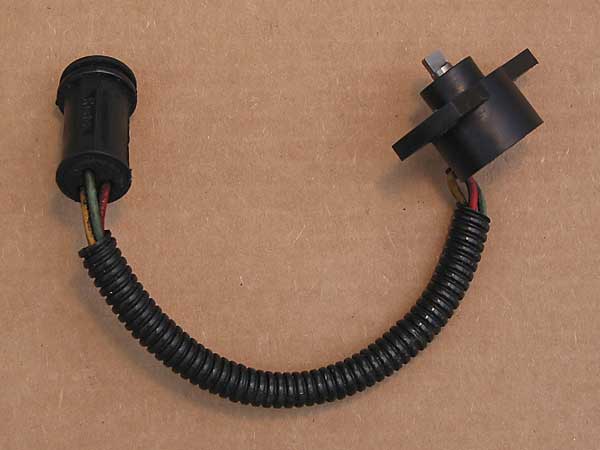
Throttle Position Sensor
The Throttle Position Sensor is mounted on the side of the plenum chamber inlet neck and is directly coupled to the throttle valve shaft. The potentiometer is a resistive device supplied with a voltage from the ECU. Movement of the throttle pedal causes the throttle valve to open, thus rotating the wiper arm within the potentiometer which in turn varies the resistance in proportion to the valve position. The ECU lengthens the injector open time when it detects a change in output voltage (rising) from the potentiometer. In addition, the ECU will weaken the mixture when it detects the potentiometer output voltage is decreasing under deceleration and will shorten the length of time the injectors are open. When the throttle is fully open, the ECU will detect the corresponding throttle potentiometer voltage and will apply full load enrichment. This is a fixed percentage and is independent of temperature. Full load enrichment is also achieved by adjusting the length of the injector open time. When the throttle is closed, overrun fuel cut off or idle speed control may be facilitated dependant on other inputs to the ECU. The throttle position sensor is designed to be self-adaptive. (At least in theory, adjustment is neither possible nor necessary. This is one small advantage of the 14CUX system over the 14CU system.)
To troubleshoot the Throttle Position Sensor, first disconnect system power and then disconnect the EFI Cable Harness from the ECU. Using an Ohmmeter, verify that resistance between terminals 3 and 25 is between 4000 and 6000 Ohms. Next, reconnect the EFI Cable Harness to the ECU, and turn the ignition key switch "on". Take voltmeter readings from pin 20 to ground. With the sensor in the throttle-closed position, you should read 0.085 to 0.545 volts. With the sensor in the throttle-open position, you should read 4.2 to 4.9 volts. In between these extremes, turning the throttle position sensor should produce a smooth sweep of voltage readings.
The Throttle Position Sensor on our example system is marked "215SA", "84925A", "Lucas", "Made in UK", and "2499". It has a 3-lead pigtail on it that's about 6" long, and the 3-pin connector on the end of the pigtail is marked "Rists". The three cables to the pigtail are color coded "yellow", "red" and "green" respectively.
Road Speed Transducer (photo not yet available)
On Range Rovers, the Road Speed Transducer is mounted on a bracket on the left hand frame rail adjacent to the motor mount. The transducer provides road speed data to the ECU (and on Range Rovers it's also needed by the speedometer). Based on input from the Road Speed Transducer, the ECU selects an appropriate fuel map. When the Road Speed Transducer is omitted or inoperable, the ECU never leaves "idle mode". It isn't clear from the Rover literature we've found exactly how many other modes the ECU might enter if it had an operational Road Speed Transducer. You can actually drive in idle mode, especially if you manually re-adjust idle speed at the MAF Sensor, but cruise fuel economy should be better with a Road Speed Transducer signal properly reaching the ECU.
For safety reasons, Range Rovers have a "kill-joy" function built into the ECU program. If the Road Speed Transducer provides too fast a signal, the vehicle will stop accelerating.
Our example system didn't come to us with a Road Speed Transducer, but we'd like to have one so we can analyze how it functions and determine how feasible it is to provide a road speed signal to the ECU from another source. (For example, anyone who fits an aftermarket electronic speedometer also fits an aftermarket speed transducer. We don't know if an aftermarket speedometer sender can be used for the fuel injection system also.)
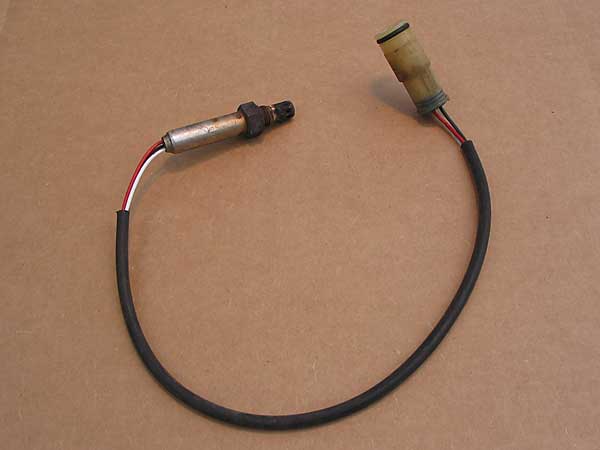
Oxygen Sensors (aka: "Lambda Sensors" or "O2 sensors")
The Oxygen Sensors provide a feedback loop. Based on their signals, the ECU is able to determine whether the air/fuel ratio is lean, rich, or okay. On Range Rovers, Oxygen Sensors are located on the exhaust pipes just downstream of the exhaust manifolds. Because oxygen sensors are more accurate when they're hot (i.e over 600° F), the oxygen sensors are equipped with integral heater elements.
Oxygen Sensors were an invention of Volvo Car Corporation in the mid 1970's. The sensing element that Volvo pioneered consisted of a "zirconia" (zirconium oxide) ceramic bulb coated with a thin layer of platinum. Over ninety-five percent of all cars that use Oxygen Sensors use zirconia, but the Rover 14CUX system DOESN'T use zirconia sensors! Instead, it uses "titania" (titanium dioxide) sensors. Although they're technically more accurate and faster reacting, titania sensors carry a premium price. Many Nissan's and some Toyota's have also been equipped with titania sensors.
Zirconia Oxygen Sensors provide a fluctuating voltage output between 0.50V and 1.00V. Titania sensors don't create a voltage signal - instead they provide a resistance signal between about 20 kilohm (for a lean mixture) and about 1 kilohm (for a rich mixture). The Rover 14CUX ECU provides the sensors a low-current 5 volt supply and measures the resulting voltage drop across the sensors. So, if you measure DC voltage across the Oxygen Sensors while the vehicle is running (by connecting a voltmeter between terminal 4 and terminals 23 and 24 respectively) you should expect to see voltage readings that vary between 0.50V and 1.00V. Very interestingly, the voltage reading will look similar to what you'd see with zirconia Oxygen Sensors. There's a subtle difference, however. On a Rover 14CUX vehicle, a 0 volt reading means "lean" and a 1 volt reading means "rich", which is the reverse of what you'd expect on most other vehicles.
Unexpectedly low average voltage readings may indicate an air leak, a contaminated injector, or low fuel pressure. Unexpectedly high voltage readings may indicate too high fuel pressure, a leaking injector or injectors, or a saturated carbon canister. If your meter has a "min-max" feature, you can also use it to check the range of oxygen sensor readings - which is actually a better test. Replace a sensor that doesn't go below 0.300 volts or above 0.700 volts.
Note: Oxygen sensors need to heat up before they can be tested meaningfully.
Of course, exhaust gases are released by the engine in rapid pulses. When working properly, an oxygen sensor should be able to sense and report changing oxygen levels very rapidly. How fast an oxygen sensor switches from high voltage to low is measured in "cross counts" (per second). The higher the number of cross counts the better. EFI computers typically expect to see eight to ten cross counts at 2000 RPM. If they don't see enough cross counts they typically throw a "check engine" light.
You can also visually inspect the tip of an oxygen sensor much like you would inspect a spark plug. Black sooty deposits indicate a rich mixture. White chalky deposits indicate silica contamination. (This is often caused by using the wrong type of RTV gasket sealant when reassembling an engine after a repair. The sealant emits a gas which is cycled into the combustion chamber by the PCV system.) White gritty deposits (or green deposits) indicate antifreeze contamination as can be caused by a blown head or intake manifold gasket. Dark brown deposits are an indication of excessive oil consumption (either from a defective PCV valve or from a mechanical problem such as worn valve guides or piston rings.)
The Oxygen Sensors on our example system are marked "Lucas", "3LS", and "NTK D3G". They have 3-lead pigtails that are 17" long, and the 3-pin connector on the end of the pigtail is unmarked. The three leads are color coded "red", "white", and "black" respectively.
Lucas 3LS sensors are actually made by NTK Technical Ceramics; apparently the only parts manufacturer in the world making oxygen sensors with 12mm X 1.25 threads. Totally interchangeable NTK sensors are available from Nissan for a much lower price than at the Rover dealer - the only difference is that you must modify your wiring to connect them. No problem! You're going to get used to modifying the Rover wire harness. Any of the following Nissan part numbers will work: "22690-88G01", "226A0-40U60", "22690-61A00" or "22960-M210". (The various Nissan sensors have different pigtails.)
My local Auto Zone cross-indexes the Rover/Lucas sensors to Bosch (part number 13946) at $138.99. They're not stocked in the store, but they can be ordered.
If you're welding new sensor bungs onto your headers anyway, a few more oxygen sensor options are open to you.
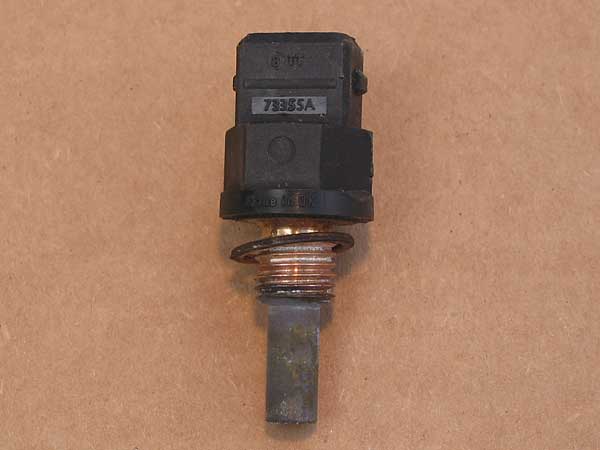
Engine Coolant Temperature Sensor (aka: "thermistor" or "thermal resistor")
The Engine Coolant Temperature Sensor is threaded into a boss on the intake manifold. Note: this sensor contacts the coolant fluid, and thus its threads need to be sealed appropriately. When the engine is "cold", as determined by this sensor, the ECU richens the fuel mixture by lengthening the time injectors stay open. The ECU reduces the length of fuel pulses as the engine reaches normal operating temperature.
The Engine Coolant Temperature Sensor on our example system is marked "73355A", "Lucas", and "Made in UK". It has a 2-pin integral sealed connector. My local Auto Zone lists this sensor as part number SU5133 at $26.99, and they keep it in stock. Although I haven't been able to verify it, I've also been told this sensor is interchangeable with the sensor in a late 1980's VW Golf.
I'm told that these sensors are a relatively frequent cause of trouble on older Rover fuel injection systems. One installer told me he replaces the Engine Coolant Temperature Sensor whenever he does an engine swap.
Fuel Temperature Sensor (aka: "thermistor" or "thermally sensitive resistor") (see fuel rail photo above)
The Fuel Temperature Sensor is threaded into a boss on the fuel rail, forward of the plenum. (See the fuel rail photograph above.) Note: this sensor does NOT contact fuel, and thus it can be removed without gasoline leakage. The information provided by this sensor is mainly of interest when the engine is being started. If the fuel in the fuel rail is already hot, the ECU "knows" a hot engine is being re-started, and can adjust the mixture accordingly.
The Fuel Temperature Sensor on our example system is marked "Lucas", "Made in UK", and "73273D". It has two terminals.
Disclaimer: This page was researched and compiled by Curtis Jacobson. Views expressed are those of the author, and are provided without warrantee or guarantee. Apply at your own risk.
Photos by Curtis Jacobson (except where noted). All rights reserved.
A Tune Resistor was originally specified in the wire harness so that one ECU part number could serve multiple vehicle markets. (Multiple computer programs could be stored within the ECU, and the ECU could "decide" which one to use based on what resistance it sensed.) One leg of the Tune Resister was wired to terminal 5 of the ECU, and the other leg was spliced to ground.
At some point during 14CUX production, Rover apparently decided to eliminate the Tune Resistor. (According to Rover service literature, this started with VIN number LA451517.) It isn't clear from the literature whether any US-market 14CUX systems would be effected by having an incorrect or damaged tune resister. The example system we photographed and described for this article NEVER HAD A TUNE RESISTOR!
The following information on Tune Resistors is based on Rover service literature.
| Visual inspection of wire color codes will allow you to quickly differentiate between resistors. | ||
| White | 3900 Ohms | USA and European vehicles with catalytic converters |
| Green | 470 Ohms | UK and European vehicles without catalytic converters |
| Yellow | 910 Ohms | Saudi vehicles (without catalytic converters.) |
| Red | 180 Ohms | Australia and "the rest of the world." |
Note: all four types of Rover Tune Resistors were rated for 0.5 Watts.
When fitted, the Tune Resistor was connected to the ECU through terminal position 5, and it was also connected to terminal position 27 through a splice. If you wish to check the resistor, first disconnect power to the system, second disconnect the EFI Cable Harness Assembly from the ECU, and finally simply measure resistance (using an Ohmmeter) from pin 5 to pin 27 on the main ECU connector. (Resistance isn't polarity dependent.)


Fuel injectors are the precision valves that meter fuel delivery. The eight fuel injectors are fitted between the pressurized fuel rail and the inlet manifold. Each injector comprises a solenoid operated needle valve with a movable plunger rigidly attached to the nozzle valve. When the solenoid is energized the plunger is attracted off its seat and allows pressurized fuel into the intake manifold.
Minimum fuel flow per injector is 160-175cc per minute using alcohol (for testing), or 180-195cc per minute using gasoline, when tested at 36.25psi (2.54kgf/cm2) at 20C +/- 2C.
Wiring faults on the injector circuits (and within the injectors) can be tested for at the ECU connector. Turn the ignition off and disconnect the ECU connector. Check the right bank of injectors by measuring resistance between terminals 2 and 11. Check the left bank of injectors by measuring resistance between terminals 2 and 13. In both cases, an Ohmmeter reading of 4-4.5 Ohms is expected. If the reading is 5-6 Ohms, suspect one bad fuel injector. A reading of 8-9 Ohms could indicate two bad injectors, and a reading of 16-17 Ohms could indicate three bad injectors. In any case, if the overall circuit resistance isn't 4-4.5 Ohms, proceed to checking for wiring faults or for open-circuit injectors.
The Injectors in our example system are marked with a green stripe painted around their circumference.
Purchasing original Bosch fuel injectors (part number ERR722, rated 23.67 lbs/hr) from the Rover dealer isn't inexpensive. In fact, even at your local discount auto parts store you can expect to pay almost $100 per injector. (Auto Zone lists GP-Sorenson part number 800-1151N at $96.99/ea. They come with a one year warranty.) Mainly for this reason, Range Rover owners have been seeking cross-references to other usable injectors for years. The internet message boards contain several (typically dramatically less expensive) cross-references (e.g. Bosch/Ford 0280150561, Accel 158021, etc.)
Since injector failure is far more likely to be from obstruction than from electrical problems, you may want to consider having your injectors professionally cleaned. One of our readers, Tony Bates, advises that this can be done for as little as $90/set. (He recommends "Affordable Fuel Injection" in Elsie Michigan.) Fuel injector service should include thorough electrical testing, ultrasonic cleaning, installation of new filter baskets and pintle caps, new o-rings, leak-down testing, spray pattern analysis, and flow testing. (Ask for the test results and make sure all the injectors are performing similarly.)

The purpose of the Bypass Air Valve is to provide a mechanism by which the fuel injection system can alter the amount of air delivered to the engine, especially when the engine is at idle. The "Bypass Air Valve" is actually a solenoid motor with a plunger that acts as a valve in conjunction with an aluminum casting that it mounts into. The valve-body casting is mounted on the rear surface of the plenum chamber by three bolts. The valve is connected by a rubber hose to the intake tract ahead of the throttle butterfly. The valve includes an integral stepper motor, featuring two windings that are controlled by the ECU, so the ECU can control the valve aperture. For example, the valve provides extra air to maintain idle speed when the engine is under increased mechanical load such as when the air conditioning compressor is engaged.
The Bypass Air Valve has four terminals, but on our example valve they aren't marked on the valve housing. To identify them, refer to the mating connector. You may verify continuity in the windings by measuring across terminal pair cavity-A (orange wire) and cavity-B (blue/grey wire), and then by measuring across terminal pair cavity-C (green/white wire) and cavity-D (red/green wire); in both tests Ohmmeter readings should show 40 to 60 Ohms resistance. If you prefer, you may take these measurements from the ECU connector by measuring at terminal pair 1 and 26 or terminal pair 28 and 29.
Reportedly, the Bypass Air Valve is one of the weakest links of the Rover 14CUX system. It can stick, and we're told that the most typical symptom of this is a fast idle of about 1,500rpm, and also "searching" idle speed when descending hills. WD40 can sometimes un-stick the valve temporarily. The Bypass Air Valve on our example system is marked "73312A" and "82494". The first marking is certainly a part number, and I suspect that the second marking is a date code that indicates the valve has been replaced at some point. If you're familiar with automotive wiring, you'll probably recognize that the connector and terminals for this valve are Packard Weather-Pack components. ("Packard Electrical Division" was part of General Motors, and was spun off to become part of "Delphi Automotive Systems".) The valve itself bears a striking resemblance to AC Delco part number 25527077, which was used on all 4.3L GM V6 engines and most 5.7L GM V8 engines. If you need one of these valves, purchasing the General Motors spec part from your local parts counter will be considerably more economical than dealing with Range Rover.

The fuel injection fault display provides two-digit diagnostic codes in a way that's very easy to read: the display has a dark red, transparent, molded plastic case. Light emitting diodes can be seen through the side of the case when a fault code is displayed. Nifty!
If multiple faults exist, the display shows the one that the ECU thinks is highest priority. Higher priority faults need to be "cleared" before lower priority faults will be displayed. A "blank" (dark) display usually indicates there are no faults.
Use this procedure to clear faults:
1. Switch "on" the ignition.
2. Disconnect the serial link mating plug, wait five seconds, and reconnect.
3. Switch "off" the ignition, and wait several seconds.
4. Switch "on" the ignition. The display should now reset.
Note: It should either show a lower priority fault code or appear dark.
| Rover Diagnostic ("Fault") Codes | ||
| 12 | Mass airflow (MAF) sensor or MAF sensor circuit | |
| 14 | Coolant temperature sensor (CTS) | |
| 15 | Fuel temperature sensor (FTS) | |
| 17 | Throttle position sensor (TPS) | |
| 18 | Throttle position sensor (TPS) | |
| 19 | Throttle position sensor (TPS) | |
| 21 | Tune resistor (open circuit) | |
| 23 | Fuel system pressure | |
| 25 | Ignition misfire | |
| 28 | Air leak | |
| 29 | Electronic control module (ECM) memory check | |
| 34 | Injector (or its wiring) - cylinder bank "A" | |
| 36 | Injector (or its wiring) - cylinder bank "B" | |
| 40 | Misfire - cylinder bank "A" | |
| 44 | Oxygen sensor - cylinder bank "A" | |
| 45 | Oxygen sensor - cylinder bank "B" | |
| 48 | Idle air control valve (also check the idle speed and road speed sensor) | |
| 50 | Misfire - cylinder bank "B" | |
| 59 | "group fault" (it's either an air leak or a fuel supply problem) | |
| 68 | Vehicle speed sensor (VSS) | |
| 69 | Gear selector switch | |
| 88 | Carbon filter solenoid valve ("purge valve") leak | |
Note: Fault code "02" will appear after a disconnected ECU is reconnected. Simply switch on the ignition to clear the display.
The Fuel Injection Fault Display on our example system is marked "Land Rover", "Range Rover On Board Diagnostic Display", "PRC", "7067", "17EM", "85008A", and "3589". It has a 4-lead pigtail on it that's about 18" long, and the 5-pin connector on the end of the pigtail is unmarked except for terminal cavity numbers.
The wires are connected as follows: 1 - Brown/Orange, 2 - Black/Grey, 3 - Pink, 4 - Not Used, and 5 - Brown/White.
SENSORS


The Mass Air Flow (MAF) Sensor consists of a cast aluminum body through which air flows. A proportion of this air flow is ducted off from the main air stream to the side into an aperture in which two wire elements are situated: one is a sensing wire and the other is a compensating wire. An integral electronic module controls a measured current of electricity through the sensing wire to produce a heating effect. The compensating wire is also connected to the module but is not heated. Engine intake air passes over the two wires causing a cooling effect, and as they're cooled their electrical resistance slightly changes. The electronic module monitors the change in resistance (and current) through the wires, and by comparing them is able to provide an output signal that is proportional to the air "mass flow rate."
As air flows through the MAF Sensor and specifically over its wire elements, inevitably some dirt accumulates. Although the mileage between cleanings seems to vary widely, the MAF Sensor will need to be cleaned occasionally. It's possible to buy "MAF Sensor Cleaner" in a spray can. Regular old "electrical contact and tuner cleaner" will work too. If cleaning as part of routine maintenance, disassembly of the sensor body isn't generally required.
The MAF Sensor provides a provision for manual engine idle speed adjustment. This provision is not widely discussed, and is certainly not intended to be any part of routine maintenance, because the electronic fuel injection system can and will automatically adjust idle speed on its own. Manual adjustment has potential (if not likelihood) of negatively affecting performance of the whole system. However, what's appropriate for your neighbor's Range Rover may not be so appropriate for your little hot-rod. Manual adjustment of idle speed may be particularly helpful if you aren't running a Vehicle Speed Sensor.
By design, under ECU managment the Bypass Air Valve automatically holds hot idle speed within a range of 665-735 RPM. (The ECU is also programmed to raise idle speed slightly higher when the air conditioning system is operating.) If the idle seems to be surging or providing an out-of-spec idle speed, the following problems are most likely:
1. Defective Bypass Air Valve.
2. Defective/disconnected Vehicle Speed Sensor.
3. Incorrect throttle plate/throttle lever position.
4. Incorrect Throttle Position Sensor adjustment.
5. Incorrect accelerator cable adjustment.
6. Ignition timing not within specification.
7. Vacuum leaks.
8. Incorrect fuel pressure.
9. Inadequate seal at the oil filler cap or dipstick.
If basic repairs or adjustments don't solve the problem, base idle speed should be adjusted.
The Air Flow Sensor on our example system is marked "Lucas", "3AM air flow meter", "Made in Japan", "Service No. 73242A", "Mfg Date 2389", "AFH55-1" and "Hitachi". It has a 6-pin connector on it, with terminal positions labeled "12", "9", "8", "7", "6", and "36" (from left to right).

The Throttle Position Sensor is mounted on the side of the plenum chamber inlet neck and is directly coupled to the throttle valve shaft. The potentiometer is a resistive device supplied with a voltage from the ECU. Movement of the throttle pedal causes the throttle valve to open, thus rotating the wiper arm within the potentiometer which in turn varies the resistance in proportion to the valve position. The ECU lengthens the injector open time when it detects a change in output voltage (rising) from the potentiometer. In addition, the ECU will weaken the mixture when it detects the potentiometer output voltage is decreasing under deceleration and will shorten the length of time the injectors are open. When the throttle is fully open, the ECU will detect the corresponding throttle potentiometer voltage and will apply full load enrichment. This is a fixed percentage and is independent of temperature. Full load enrichment is also achieved by adjusting the length of the injector open time. When the throttle is closed, overrun fuel cut off or idle speed control may be facilitated dependant on other inputs to the ECU. The throttle position sensor is designed to be self-adaptive. (At least in theory, adjustment is neither possible nor necessary. This is one small advantage of the 14CUX system over the 14CU system.)
To troubleshoot the Throttle Position Sensor, first disconnect system power and then disconnect the EFI Cable Harness from the ECU. Using an Ohmmeter, verify that resistance between terminals 3 and 25 is between 4000 and 6000 Ohms. Next, reconnect the EFI Cable Harness to the ECU, and turn the ignition key switch "on". Take voltmeter readings from pin 20 to ground. With the sensor in the throttle-closed position, you should read 0.085 to 0.545 volts. With the sensor in the throttle-open position, you should read 4.2 to 4.9 volts. In between these extremes, turning the throttle position sensor should produce a smooth sweep of voltage readings.
The Throttle Position Sensor on our example system is marked "215SA", "84925A", "Lucas", "Made in UK", and "2499". It has a 3-lead pigtail on it that's about 6" long, and the 3-pin connector on the end of the pigtail is marked "Rists". The three cables to the pigtail are color coded "yellow", "red" and "green" respectively.
Road Speed Transducer (photo not yet available)
On Range Rovers, the Road Speed Transducer is mounted on a bracket on the left hand frame rail adjacent to the motor mount. The transducer provides road speed data to the ECU (and on Range Rovers it's also needed by the speedometer). Based on input from the Road Speed Transducer, the ECU selects an appropriate fuel map. When the Road Speed Transducer is omitted or inoperable, the ECU never leaves "idle mode". It isn't clear from the Rover literature we've found exactly how many other modes the ECU might enter if it had an operational Road Speed Transducer. You can actually drive in idle mode, especially if you manually re-adjust idle speed at the MAF Sensor, but cruise fuel economy should be better with a Road Speed Transducer signal properly reaching the ECU.
For safety reasons, Range Rovers have a "kill-joy" function built into the ECU program. If the Road Speed Transducer provides too fast a signal, the vehicle will stop accelerating.
Our example system didn't come to us with a Road Speed Transducer, but we'd like to have one so we can analyze how it functions and determine how feasible it is to provide a road speed signal to the ECU from another source. (For example, anyone who fits an aftermarket electronic speedometer also fits an aftermarket speed transducer. We don't know if an aftermarket speedometer sender can be used for the fuel injection system also.)

The Oxygen Sensors provide a feedback loop. Based on their signals, the ECU is able to determine whether the air/fuel ratio is lean, rich, or okay. On Range Rovers, Oxygen Sensors are located on the exhaust pipes just downstream of the exhaust manifolds. Because oxygen sensors are more accurate when they're hot (i.e over 600° F), the oxygen sensors are equipped with integral heater elements.
Oxygen Sensors were an invention of Volvo Car Corporation in the mid 1970's. The sensing element that Volvo pioneered consisted of a "zirconia" (zirconium oxide) ceramic bulb coated with a thin layer of platinum. Over ninety-five percent of all cars that use Oxygen Sensors use zirconia, but the Rover 14CUX system DOESN'T use zirconia sensors! Instead, it uses "titania" (titanium dioxide) sensors. Although they're technically more accurate and faster reacting, titania sensors carry a premium price. Many Nissan's and some Toyota's have also been equipped with titania sensors.
Zirconia Oxygen Sensors provide a fluctuating voltage output between 0.50V and 1.00V. Titania sensors don't create a voltage signal - instead they provide a resistance signal between about 20 kilohm (for a lean mixture) and about 1 kilohm (for a rich mixture). The Rover 14CUX ECU provides the sensors a low-current 5 volt supply and measures the resulting voltage drop across the sensors. So, if you measure DC voltage across the Oxygen Sensors while the vehicle is running (by connecting a voltmeter between terminal 4 and terminals 23 and 24 respectively) you should expect to see voltage readings that vary between 0.50V and 1.00V. Very interestingly, the voltage reading will look similar to what you'd see with zirconia Oxygen Sensors. There's a subtle difference, however. On a Rover 14CUX vehicle, a 0 volt reading means "lean" and a 1 volt reading means "rich", which is the reverse of what you'd expect on most other vehicles.
Unexpectedly low average voltage readings may indicate an air leak, a contaminated injector, or low fuel pressure. Unexpectedly high voltage readings may indicate too high fuel pressure, a leaking injector or injectors, or a saturated carbon canister. If your meter has a "min-max" feature, you can also use it to check the range of oxygen sensor readings - which is actually a better test. Replace a sensor that doesn't go below 0.300 volts or above 0.700 volts.
Note: Oxygen sensors need to heat up before they can be tested meaningfully.
Of course, exhaust gases are released by the engine in rapid pulses. When working properly, an oxygen sensor should be able to sense and report changing oxygen levels very rapidly. How fast an oxygen sensor switches from high voltage to low is measured in "cross counts" (per second). The higher the number of cross counts the better. EFI computers typically expect to see eight to ten cross counts at 2000 RPM. If they don't see enough cross counts they typically throw a "check engine" light.
You can also visually inspect the tip of an oxygen sensor much like you would inspect a spark plug. Black sooty deposits indicate a rich mixture. White chalky deposits indicate silica contamination. (This is often caused by using the wrong type of RTV gasket sealant when reassembling an engine after a repair. The sealant emits a gas which is cycled into the combustion chamber by the PCV system.) White gritty deposits (or green deposits) indicate antifreeze contamination as can be caused by a blown head or intake manifold gasket. Dark brown deposits are an indication of excessive oil consumption (either from a defective PCV valve or from a mechanical problem such as worn valve guides or piston rings.)
The Oxygen Sensors on our example system are marked "Lucas", "3LS", and "NTK D3G". They have 3-lead pigtails that are 17" long, and the 3-pin connector on the end of the pigtail is unmarked. The three leads are color coded "red", "white", and "black" respectively.
Lucas 3LS sensors are actually made by NTK Technical Ceramics; apparently the only parts manufacturer in the world making oxygen sensors with 12mm X 1.25 threads. Totally interchangeable NTK sensors are available from Nissan for a much lower price than at the Rover dealer - the only difference is that you must modify your wiring to connect them. No problem! You're going to get used to modifying the Rover wire harness. Any of the following Nissan part numbers will work: "22690-88G01", "226A0-40U60", "22690-61A00" or "22960-M210". (The various Nissan sensors have different pigtails.)
My local Auto Zone cross-indexes the Rover/Lucas sensors to Bosch (part number 13946) at $138.99. They're not stocked in the store, but they can be ordered.
If you're welding new sensor bungs onto your headers anyway, a few more oxygen sensor options are open to you.

The Engine Coolant Temperature Sensor is threaded into a boss on the intake manifold. Note: this sensor contacts the coolant fluid, and thus its threads need to be sealed appropriately. When the engine is "cold", as determined by this sensor, the ECU richens the fuel mixture by lengthening the time injectors stay open. The ECU reduces the length of fuel pulses as the engine reaches normal operating temperature.
| The Coolant Temperature Sensor should change resistance with heat, per the following specs. | ||
| 10C | (14°F) | 9100-9300 Ohms |
| 0C | (32°F) | 5700-5900 Ohms |
| 20C | (68°F) | 2400-2600 Ohms |
| 40C | (104°F) | 1100-1300 Ohms |
| 60C | (140°F) | 500-700 Ohms |
| 80C | (176°F) | 300-400 Ohms |
| 100C | (212°F) | 150-200 Ohms |
The Engine Coolant Temperature Sensor on our example system is marked "73355A", "Lucas", and "Made in UK". It has a 2-pin integral sealed connector. My local Auto Zone lists this sensor as part number SU5133 at $26.99, and they keep it in stock. Although I haven't been able to verify it, I've also been told this sensor is interchangeable with the sensor in a late 1980's VW Golf.
I'm told that these sensors are a relatively frequent cause of trouble on older Rover fuel injection systems. One installer told me he replaces the Engine Coolant Temperature Sensor whenever he does an engine swap.
Fuel Temperature Sensor (aka: "thermistor" or "thermally sensitive resistor") (see fuel rail photo above)
The Fuel Temperature Sensor is threaded into a boss on the fuel rail, forward of the plenum. (See the fuel rail photograph above.) Note: this sensor does NOT contact fuel, and thus it can be removed without gasoline leakage. The information provided by this sensor is mainly of interest when the engine is being started. If the fuel in the fuel rail is already hot, the ECU "knows" a hot engine is being re-started, and can adjust the mixture accordingly.
The Fuel Temperature Sensor on our example system is marked "Lucas", "Made in UK", and "73273D". It has two terminals.
ADDITIONAL INFORMATION
| If you like this article, you'll probably also like: | ||
| 1 | Glen Towery's Method for Installing Rover Hot-Wire EFI by Greg Myer, | |
| 2 | British V8 2007 Tech Session: How To Install Rover EFI presented by Jim Stuart, and | |
| 3 | Fuel Injection: Not Such a Black Art by Roger Parker. | |
| You may also like to review how Rover EFI systems have been installed on these sports cars: | ||
| 1 | Evan Amaya's Rover powered 1964 MGB | |
| 2 | Neil Brown's Triumph powered 1968 Triumph TR-250 | |
| 3 | Bob Edgeworth's Rover powered 1972 MGB | |
| 4 | Mark Mallaby's Rover powered MG RV8 | |
| 5 | Scott Miller's Rover powered MG RV8 | |
| 6 | Nick Nicholas's Rover powered MGB | |
| 7 | Jim Stuart's Rover powered 1966 MGB | |
| 8 | Glen Towery's Rover powered 1974 MGB/GT | |
| 9 | Barry Yardley's Rover powered 1977 MGB | |
| 10 | Edd Weninger's Rover powered 1977 MGB | |
A WORD OF THANKS
This article wouldn't have come together without a very generous gift from one of our newsletter's readers. Alex Manelis of Lindenwold, New Jersey kindly gave us the Rover fuel injection system that you see photographed here. Alex is simply a very nice guy with a passion for our hobby. He didn't ask us to promote his shop, but we'll give him a "shout out" here anyway! Lindenwold is in the eastern suburbs of Philadelphia. If you're anywhere near Philadelphia we hope you'll consider having your cars serviced by: R.A.M. Auto Repair, Inc. 110A N. White Horse Pike, Lindenwold, NJ 08021. Phone: (856) 435-2200Disclaimer: This page was researched and compiled by Curtis Jacobson. Views expressed are those of the author, and are provided without warrantee or guarantee. Apply at your own risk.
Photos by Curtis Jacobson (except where noted). All rights reserved.

